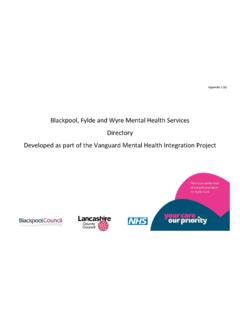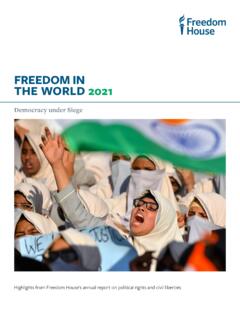Transcription of Working of Institutions - NCERT
1 56 DEMOCRATIC POLITICSOVERVIEWD emocracy is not just about people electing their rulers. In a democracythe rulers have to follow some rules and procedures. They have to workwith and within Institutions . This chapter is about the Working of suchinstitutions in a democracy . We try to understand this by looking at themanner in which major decisions are taken and implemented in ourcountry. We also look at how disputes regarding these decisions areresolved. In this process we come across three Institutions that play a keyrole in major decisions legislature, executive and have already read something about these Institutions in earlierclasses. Here we shall quickly summarise those and move on to askinglarger questions. In the case of each institution we ask: What does thisinstitution do? How is this institution connected to other Institutions ?What makes its functioning more or less democratic? The basic objectivehere is to understand how all these Institutions together carry on thework of government.
2 Sometimes we compare these with similar institutionsin other democracies. In this chapter we take our examples from theworking of the national level government called Central Government, UnionGovernment, or just Government of India. While reading this chapter, youcan think of and discuss examples from the Working of the government inyour 4 Working HOW IS A MAJOR POLICY DECISION TAKEN?Pensions, signed the Order. It wasquite short, barely one page. Itlooked like any ordinary circular ornotice that you may have seen inschool. The government issues hun-dreds of orders every day on differ-ent matters. But this one was veryimportant and became a source ofcontroversy for several years. Let ussee how the decision was taken andwhat happened Government OrderA Government OrderA Government OrderA Government OrderA Government OrderOn August 13, 1990, the Governmentof India issued an Order.
3 It wascalled an Office Memorandum. Likeall government orders, it had a num-ber and is known by that: O. M. (SCT), The Joint Secretary, anofficer in the Department of Person-nel and Training in the Ministry ofPersonnel, Public Grievances andWORKING OF INSTITUTIONS2021-2258 DEMOCRATIC POLITICSThis Order announced a majorpolicy decision. It said that 27 percent of the vacancies in civil postsand services under the Governmentof India are reserved for the Sociallyand Educationally Backward Classes(SEBC). SEBC is another name for allthose people who belong to castesthat are considered backward by thegovernment. The benefit of job res-ervation was till then available onlyto Scheduled Castes and ScheduledTribes. Now a new third categorycalled SEBC was introduced. Onlypersons who belong to backwardclasses were eligible for this quotaof 27 per cent jobs. Others could notcompete for these Dhe Dhe Dhe Dhe Deeeeecision Mcision Mcision Mcision Mcision MakakakakakersersersersersWho decided to issue thisMemorandum?
4 Clearly, such a bigdecision could not have been takenby the person who signed thatdocument. The officer was merelyimplementing the instructions givenby the Minister of Personnel, PublicGrievances and Pensions, of whichthe Department was a part. We canguess that such a major decisionwould have involved other majorfunctionaries in our country. Youhave already read in the previousclass about some of them. Let us goover some of the main points thatyou covered then:<President is the head of the stateand is the highest formal authorityin the country.<Prime Minister is the head of thegovernment and actually exercisesall governmental powers. He takesmost of the decisions in theCabinet meetings.<Parliament consists of thePresident and two Houses, LokSabha and Rajya Sabha. The PrimeMinister must have the support ofa majority of Lok Sabha , were all these people involvedin this decision regarding the OfficeMemorandum?
5 Let us find <Which points, other than the ones mentionedabove, do you recall about these institutionsfrom the previous class? Discuss in class.<Can you think of a major decision made byyour state government? How were the Gover-nor, the Council of Ministers, the state assem-bly and the courts involved in that decision?This Office Memorandum was theculmination of a long chain ofevents. The Government of India hadappointed the Second BackwardClasses Commission in 1979. It washeaded by Mandal. Hence it waspopularly called the MandalCommission. It was asked todetermine the criteria to identify thesocially and educationally backwardclasses in India and recommendsteps to be taken for theiradvancement. The Commission gaveits Report in 1980 and made manyrecommendations. One of these wasthat 27 per cent of government jobsbe reserved for the socially andeducationally backward Report and recommendationswere discussed in the several years, manyparliamentarians and parties keptdemanding the implementation ofthe Commission s came the Lok Sabha electionof 1989.
6 In its election manifesto,the Janata Dal promised that if votedto power, it would implement theMandal Commission report. TheJanata Dal did form the governmentafter this election. Its leader V. became the Prime developments took placeafter that:Now I can seeclearly! That is whythey talk ofMandalisation ofpolitics. Don t they?Is every OfficeMemorandum amajor politicaldecision? If not,what made thisone different?2021-2259were full of different views andopinions on this issue. It led towidespread protests and counter-protests, some of which were reacted strongly because thisdecision affected thousands of jobopportunities. Some felt thatexistence of inequalities amongpeople of different castes in Indianecessitated job reservations. Theyfelt, this would give a fairopportunity to those communitieswho so far had not adequately beenrepresented in felt that this was unfair asit would deny equality of opportunityto those who did not belong tobackward communities.
7 They wouldbe denied jobs even though theycould be more qualified. Some feltthat this would perpetuate castefeelings among people and hampernational unity. In this chapter wewon t discuss whether the decisionwas good or not. We only take thisexample to understand how majordecisions are taken andimplemented in the resolved this dispute? Youknow that the Supreme Court and theHigh Courts in India settle disputesarising out of governmental persons and associationsopposed to this order filed a numberof cases in the courts. They appealedto the courts to declare the orderinvalid and stop its Supreme Court of India bunchedall these cases together. This case wasknown as the Indira Sawhney andothers Vs Union of India case . Elevenjudges of the Supreme Court heardarguments of both sides. By amajority, the Supreme Court judgesin 1992 declared that this order of theGovernment of India was valid.
8 Atthe same time the Supreme Courtasked the government to modify itsWORKING OF Institutions <The President of India in hisaddress to the Parliamentannounced the intention of thegovernment to implement therecommendations of the MandalCommission.<On 6 August 1990, the UnionCabinet took a formal decision toimplement the recommendations.<Next day Prime Minister Singhinformed the Parliament aboutthis decision through a statementin both the Houses of Parliament.<The decision of the Cabinet wassent to the Department of Personneland Training. The senior officers ofthe Department drafted an order inline with the Cabinet decision andtook the minister s approval. Anofficer signed the order on behalf ofthe Union Government. This washow No. 36012/ 31/90 wasborn on 13 August the next few months, this wasthe most hotly debated issue in thecountry. Newspapers and magazinesReservation debatewas such animportant issue during1990-91 thatadvertisers used thistheme to sell theirproducts.
9 Can youspot some referencesto political events anddebates in these AmulButter hoardings? GCMMF Indiarrrrreeeeeaaaaadddddttttthehehehehe imaimaimaimaimagegegegege2021-2260 DEMOCRATIC POLITICSWho did what in this case of reservations for backward classes?Made formal announcement about this decisionImplemented the decision by issuing an orderTook the decision to give 27% job reservationsUpheld reservations as validCHECKYOURPROGRESS original order. It said that well-to-do persons among the backwardclasses should be excluded fromgetting the benefit of , the Department ofWhich institutionsare at work in therunning of yourschool? Would itbe better if oneperson alone tookall the decisionsregardingmanagement ofyour school?Personnel and Training issuedanother Office Memorandum on8 September 1993. The disputethus came to an end and this policyhas been followed since fd fd fd fd for Por Por Por Por Political Institutionsolitical Institutionsolitical Institutionsolitical Institutionsolitical InstitutionsWe have seen one example of howthe government works.
10 Governing acountry involves various suchactivities. For example, thegovernment is responsible forensuring security to the citizens andproviding facilities for educationand health to all. It collects taxesand spends the money thus raisedon administration, defence anddevelopment programmes. Itformulates and implements severalwelfare schemes. Some persons haveto take decisions on how to go aboutthese activities. Others have toimplement these decisions. Ifdisputes arise on these decisions orin their implementation, there shouldbe someone to determine what isright and what is wrong. It isimportant that everyone shouldknow who is responsible for doingwhat. It is also important that theseactivities keep taking place even ifthe persons in key positions , to attend to all these tasks,several arrangements are made inall modern democracies. Sucharrangements are called democracy works well when theseinstitutions perform functionsassigned to them.












